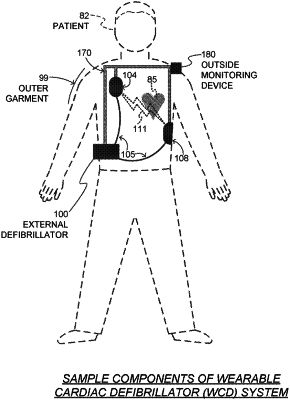| CPC A61N 1/37254 (2017.08) [A61B 5/02405 (2013.01); A61B 5/053 (2013.01); A61B 5/11 (2013.01); A61B 5/4836 (2013.01); A61B 5/6801 (2013.01); A61B 5/742 (2013.01); A61B 5/7405 (2013.01); A61N 1/3904 (2017.08); A61N 1/3925 (2013.01); A61N 1/3968 (2013.01); A61N 1/3975 (2013.01); A61N 1/3987 (2013.01); A61N 1/3993 (2013.01); A61B 5/74 (2013.01); A61B 2560/0242 (2013.01); A61N 1/39 (2013.01); A61N 1/39044 (2017.08); A61N 1/39046 (2017.08)] | 20 Claims |

|
1. A wearable cardiac defibrillator (WCD) system, comprising:
a support structure configured to be worn by a patient;
a power source;
an energy storage module configured to receive an electrical charge from the power source, and to store the received electrical charge;
a measurement circuit configured to render a physiological input from a patient physiological signal;
a motion sensor configured to measure motion data of a patient;
a location sensor configured to measure location data indicative of a location of the patient wherein the location data is used to inform the determination of whether the shock condition has been met;
a processor configured to determine from the physiological input whether or not a shock condition is met;
a discharge circuit configured to be coupled to the energy storage module and configured to discharge the stored electrical charge through the patient while the support structure is worn by the patient when the shock condition is met;
a cancel switch configured to be actuated in conjunction with receiving a validation input entered by a person, in which when the cancel switch is sensed to have been actuated it prevents the electrical charge from being discharged even when the shock condition is met, but the electrical charge is so prevented only when the entered validation input meets a validity criterion and in response to the motion data of the patient exceeds a spuriousness threshold, the actuation of the cancel switch is ignored, and an electrical shock is discharged.
|